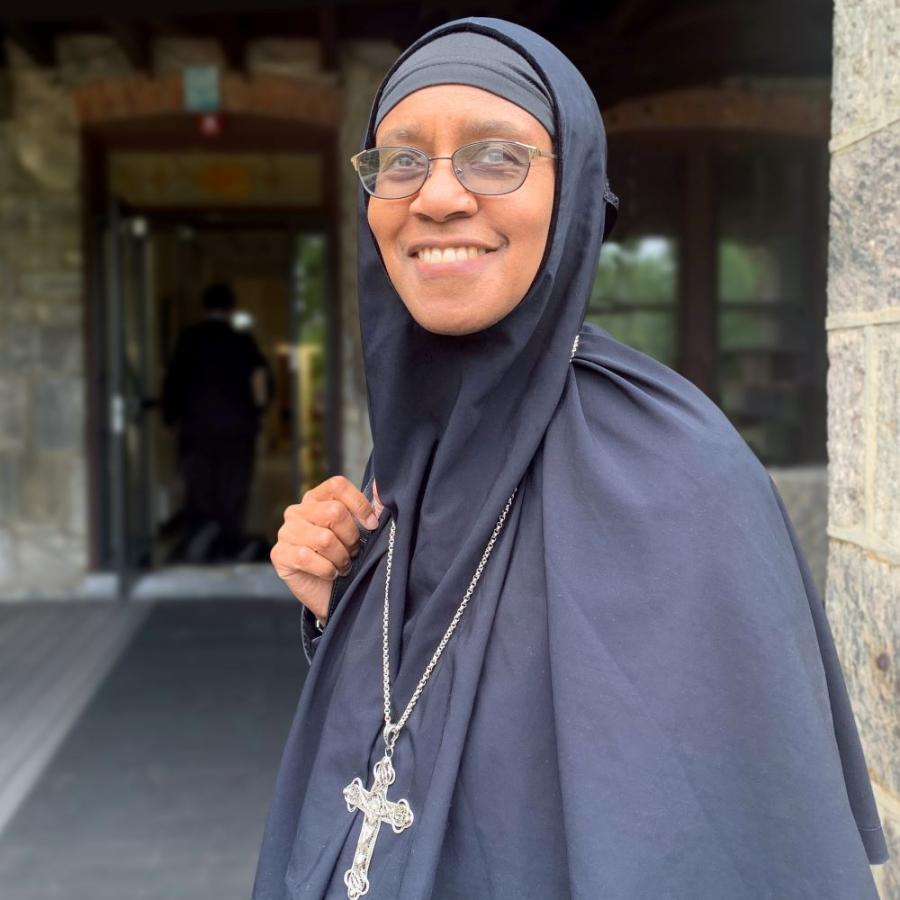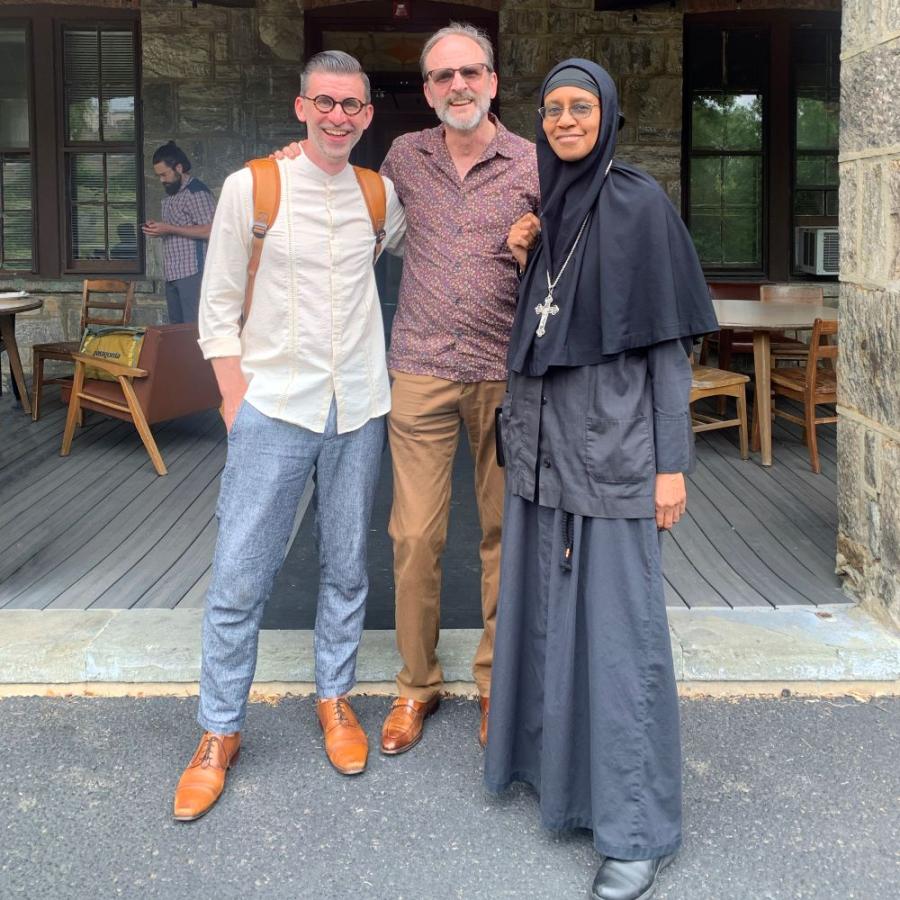
Abbess (then Mother) Katherine Weston was our Woman of the Week in July 2022. She was nominated then for her work in racial reconciliation, her 30-year leadership of her monastery, her presidency of the national organization called the Fellowship of St. Moses the Black (of which she was a founding member), her iconography and writing, and her work as a psychotherapist. You see her here in June this year at St. Vladimir’s Seminary’s Summer Institute, where she was one of three guest composers of Orthodox liturgical music, and with reliquary icons she painted for the monastery, holding an icon she restored.
In her original WOW pieces, she began, “This is how the saints and the icons drew me into the Holy Orthodox Church: I was raised in the historic St. Philip’s Episcopal Church in Harlem, where my father was rector. St. Philip’s boasts a soaring neo-Gothic nave; the arches of the hammer-beam roof sit on carved corbels, each in the likeness of a different saint. One of them is St. Mary of Egypt, now my patron saint in Orthodox baptism. I credit her for praying me into the Faith.”
Seven months ago, Mother Katherine was elevated to the rank of abbess of her monastery, St. Xenia Methochion in Indianapolis. The monastery is characterized by the creativity of its sisters (among them are editors, authors, poets, iconographers, and a composer). Their outreach involves them closely with the Fellowship of St. Moses the Black, of which she is president: “In monasticism, you can’t take the path of the world, which is advertising, trying to be attractive, trying to be enticing, trying to package things in ways that appeal to someone’s ego. Most advertising is based on encouraging sin, really, like gluttony, and it's really the opposite approach. You discourage in order to make sure it’s what the person really wants to do because we are less capable of making long-term commitments than people in the past. We don’t want someone to come to monasticism thinking, I’ll try it out for a few years, and if I’m bored or it’s not for me, I’ll go on and try something else. It requires building in the capacity for stability and steadfastness in a culture that doesn’t really value that or help form it.” (“Monasticism, Outreach and New Orthodox Music” on the GOA’s Orthodox Christian Network, YouTube)

We are giving an update of the work of Abbess Katherine Weston, especially around her settings of Orthodox sacred music inspired by African-American spirituals. You see her here at St. Vladimir’s Seminary with Benedict Sheehan and Dr. Peter Bouteneff:
For a little background, Abbess Katherine has had a long history with music. Her grandmother was a graduate of Fisk University, “where the spirituals came out of the field onto the stage,” as she puts it, which meant she grew up with those melodies. She has also made a lifelong habit of musical notation. In the 1990s, as part of the monastery’s outreach, she composed, performed, and recorded songs for a coffeehouse youth program. Eighteen years ago, on behalf of the Fellowship, she began experimenting with using African-American Spirituals as a source or inspiration for Orthodox liturgical composition. Her first undertaking was a setting for the anaphora, which was sung by three voices at the 2006 Fellowship conference.
In 2019 she met Zhanna Lehmann, who holds a doctorate in musical arts and choral conducting and who had become interested in spirituals while still living in Russia. Dr. Lehmann not only included some of Abbess Katherine’s piece in concerts and on a CD, but also challenged her to do a setting of an entire liturgy, which she finished on the Sunday of the Samaritan woman this year. Recently her liturgical work has begun to attract wider attention.
In 2022, she was the editor of Jubilation: Cultures of Sacred Music, a volume of collected essays that examine the dialogue between Orthodox liturgical music and Black spirituals and gospel music.
This October, she will premier her brand-new setting for the Liturgy of St. John Chrysostom at the Fellowship’s conference in Houston that is fittingly called Anchored in the Lord, after the name of a spiritual.
Her collaboration with Dr. Lehmann finds the Illinois Orthodox Choir performing and recording her pieces.
As a guest composer, she presented her work at the St. Vladimir’s Seminary Summer Institute, “Sing to the Lord a New Song: American Orthodox Music” Some of her pieces were included in the liturgy conducted by Grammy award-nominated conductor and composer Benedict Sheehan.
Her work is being used in liturgical services with the blessing of His Eminence Archbishop Elpidophoros, an archimandrite from Nigeria, Fr. Chrysostom, is doing missionary outreach services to the black community in New York. The mission has a blessing to try using her work in Liturgy to see if the settings are suitable. This will entail taking pieces written for 4-part choirs, and arranging them for fewer voices—even for a single cantor.
Abbess Katherine has expressed the hope that it will be possible to perform her compositions in Black neighborhoods or in public squares. She knows of Black people who love Orthodox theology but find the music to be a dealbreaker. “If a Black family comes into an Orthodox church and hears my music and thinks, 'This sounds like us—it sounds like church,” then I’ve fulfilled my mission. Of course, it’s not my music: it's the music of the spiritual ancestors, offered to God anew in Orthodox Liturgy.”


